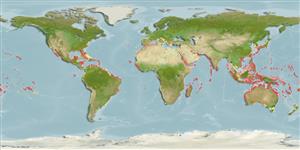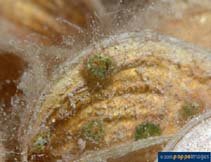Padina gymnospora (Kützing) Sonder, 1871
Funnelweed| Native range | All suitable habitat | Point map | Year 2050 |

|
| This map was computer-generated and has not yet been reviewed. |
| Padina gymnospora AquaMaps Data sources: GBIF OBIS |
Classification / Names Common names | Synonyms | CoL | ITIS | WoRMS
Phaeophyceae | Dictyotales | Dictyotaceae
Environment: milieu / climate zone / depth range / distribution range Ecology
Sessile; brackish; depth range 0 - 14 m (Ref. 83908). Tropical
Distribution Countries | FAO areas | Ecosystems | Occurrences | Introductions
Atlantic Ocean: from North Carolina, USA south to Brazil including the Gulf of Mexico, Caribbean and Bermuda, east to Salvage (Selvagens) Islands and south to Angola, including the Mediterranean (Israel), Canary, Cape Verde and Ascension Island; Indian Ocean: In the Arabian Sea south to South Africa, including the Persian Gulf, Seychelles, Madagascar and Réunion, east to India and south to Western Australia including Bay of Bengal and Andaman Sea; Pacific Ocean: from Korea to the South China Sea south to Queensland, Australia, east to Hawaiian Islands including Federated States of Micronesia, Fiji and Samoan Archipelago.
Length at first maturity / Size / Weight / Age
Maturity: Lm ? range ? - ? cm Max length : 6.5 cm TL male/unsexed; (Ref. 82093)
Short description Morphology
Life cycle and mating behavior Maturity | Reproduction | Spawning | Eggs | Fecundity | Larvae
Main reference
References | Coordinator | Collaborators
Guiry, M.D. and G.M. Guiry 2009 AlgaeBase. World-wide electronic publication, National University of Ireland, Galway. http://www.algaebase.org; searched on 14 April 2009. (Ref. 80701)
IUCN Red List Status
(Ref. 130435: Version 2025-1)
CITES status (Ref. 108899)
CMS (Ref. 116361)
Threat to humans
Human uses
| FishSource |
Tools
More information
Diet composition
Food consumption
Predators
Max. ages / sizes
Length-weight rel.
Length-length rel.
Length-frequencies
Mass conversion
Abundance
Maturity
Fecundity
Spawning
Eggs
Egg development
Larvae
Internet sources
BHL | BOLD Systems | CISTI | DiscoverLife | FAO(Publication : search) | Fishipedia | GenBank (genome, nucleotide) | GloBI | Gomexsi | Google Books | Google Scholar | Google | PubMed | AlgaeBase | Tree of Life | Wikipedia (Go, Search) | Zoological Record



